Suggestions or feedback?

MIT News | Massachusetts Institute of Technology
- Machine learning
- Sustainability
- Black holes
- Classes and programs
Departments
- Aeronautics and Astronautics
- Brain and Cognitive Sciences
- Architecture
- Political Science
- Mechanical Engineering
Centers, Labs, & Programs
- Abdul Latif Jameel Poverty Action Lab (J-PAL)
- Picower Institute for Learning and Memory
- Lincoln Laboratory
- School of Architecture + Planning
- School of Engineering
- School of Humanities, Arts, and Social Sciences
- Sloan School of Management
- School of Science
- MIT Schwarzman College of Computing
Soft robotic fish swims alongside real ones in coral reefs
Press contact :.
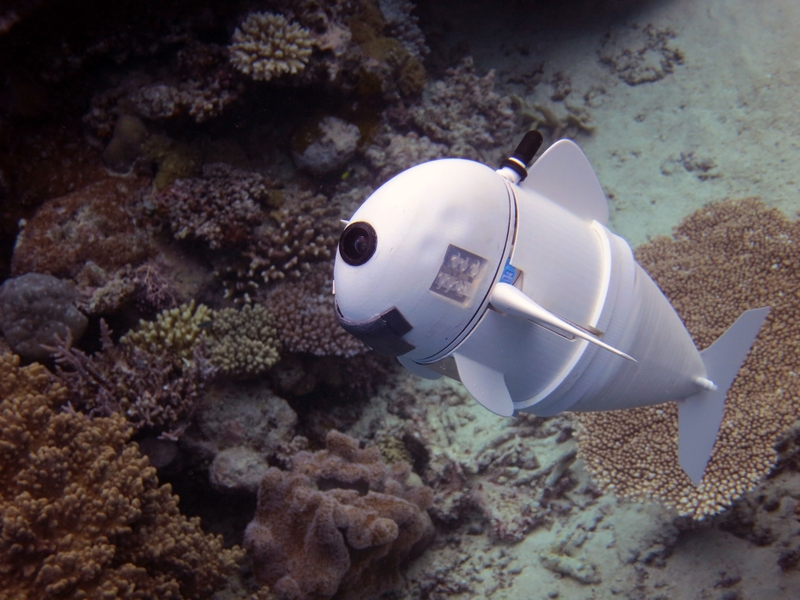
Previous image Next image
This month scientists published rare footage of one of the Arctic’s most elusive sharks. The findings demonstrate that, even with many technological advances in recent years, it remains a challenging task to document marine life up close.
But MIT computer scientists believe they have a possible solution: using robots.
In a paper out today, a team from MIT’s Computer Science and Artificial Intelligence Laboratory (CSAIL) unveiled “SoFi,” a soft robotic fish that can independently swim alongside real fish in the ocean.
During test dives in the Rainbow Reef in Fiji, SoFi swam at depths of more than 50 feet for up to 40 minutes at once, nimbly handling currents and taking high-resolution photos and videos using (what else?) a fisheye lens.
Using its undulating tail and a unique ability to control its own buoyancy, SoFi can swim in a straight line, turn, or dive up or down. The team also used a waterproofed Super Nintendo controller and developed a custom acoustic communications system that enabled them to change SoFi’s speed and have it make specific moves and turns.
“To our knowledge, this is the first robotic fish that can swim untethered in three dimensions for extended periods of time,” says CSAIL PhD candidate Robert Katzschmann, lead author of the new journal article published today in Science Robotics . “We are excited about the possibility of being able to use a system like this to get closer to marine life than humans can get on their own.”
Katzschmann worked on the project and wrote the paper with CSAIL director Daniela Rus, graduate student Joseph DelPreto and former postdoc Robert MacCurdy, who is now an assistant professor at the University of Colorado at Boulder.
How it works
Existing autonomous underwater vehicles (AUVs) have traditionally been tethered to boats or powered by bulky and expensive propellers.
In contrast, SoFi has a much simpler and more lightweight setup, with a single camera, a motor, and the same lithium polymer battery that’s found in consumer smartphones. To make the robot swim, the motor pumps water into two balloon-like chambers in the fish’s tail that operate like a set of pistons in an engine. As one chamber expands, it bends and flexes to one side; when the actuators push water to the other channel, that one bends and flexes in the other direction.
These alternating actions create a side-to-side motion that mimics the movement of a real fish. By changing its flow patterns, the hydraulic system enables different tail maneuvers that result in a range of swimming speeds, with an average speed of about half a body length per second.
“The authors show a number of technical achievements in fabrication, powering, and water resistance that allow the robot to move underwater without a tether,” says Cecilia Laschi, a professor of biorobotics at the Sant'Anna School of Advanced Studies in Pisa, Italy. “A robot like this can help explore the reef more closely than current robots, both because it can get closer more safely for the reef and because it can be better accepted by the marine species.”
The entire back half of the fish is made of silicone rubber and flexible plastic, and several components are 3-D-printed, including the head, which holds all of the electronics. To reduce the chance of water leaking into the machinery, the team filled the head with a small amount of baby oil, since it’s a fluid that will not compress from pressure changes during dives.
Indeed, one of the team’s biggest challenges was to get SoFi to swim at different depths. The robot has two fins on its side that adjust the pitch of the fish for up and down diving. To adjust its position vertically, the robot has an adjustable weight compartment and a “buoyancy control unit” that can change its density by compressing and decompressing air.
Katzschmann says that the team developed SoFi with the goal of being as nondisruptive as possible in its environment, from the minimal noise of the motor to the ultrasonic emissions of the team’s communications system, which sends commands using wavelengths of 30 to 36 kilohertz.
“The robot is capable of close observations and interactions with marine life and appears to not be disturbing to real fish,” says Rus.
The project is part of a larger body of work at CSAIL focused on soft robots, which have the potential to be safer, sturdier, and more nimble than their hard-bodied counterparts. Soft robots are in many ways easier to control than rigid robots, since researchers don’t have to worry quite as much about having to avoid collisions.
“Collision avoidance often leads to inefficient motion, since the robot has to settle for a collision-free trajectory,” says Rus, the Andrew and Erna Viterbi Professor of Electrical Engineering and Computer Science at MIT. “In contrast, a soft robot is not just more likely to survive a collision, but could use it as information to inform a more efficient motion plan next time around.”
As next steps the team will be working on several improvements on SoFi. Katzschmann plans to increase the fish’s speed by improving the pump system and tweaking the design of its body and tail.
He says that they also plan to soon use the on-board camera to enable SoFi to automatically follow real fish, and to build additional SoFis for biologists to study how fish respond to different changes in their environment.
“We view SoFi as a first step toward developing almost an underwater observatory of sorts,” says Rus. “It has the potential to be a new type of tool for ocean exploration and to open up new avenues for uncovering the mysteries of marine life.”
This project was supported by the National Science Foundation.
Share this news article on:
Press mentions.
Researchers at MIT developed SoFi, a soft robotic fish designed to study underwater organisms and their environments, reports Mashable . “The soft robotic fish serves a nice purpose for hopefully minimizing impact on the environments that we’re studying and also helps us study different types of behaviors and also study the actual mechanics of these organisms as well,” says graduate student Levi Cai.
Popular Mechanics
In an article for Popular Mechanics , Tiana Cline spotlights SoFi, an autonomous, soft, robotic fish that can swim alongside real fish. “SoFi has the potential to be a new type of tool for ocean exploration and to open up new avenues for uncovering the mysteries of marine life,” Cline notes.
SoFi, or “soft robot fish”, was developed by researchers in CSAIL to better observe marine life without disturbance. “…it's specially designed to look realistic and move super-quietly through the waves,” writes BBC News , whose brief also features a video of the fish in action.
Sarah Toy of The Wall Street Journal writes that CSAIL researchers have developed a soft robotic fish that can capture images and video of aquatic life. “The key here is that the robot is very quiet as it moves in the water and the undulating motion of the tail does not create too much water disturbance,” says Prof. Daniela Rus.
The New York Times
Using sound waves manipulated by a Super Nintendo controller, CSAIL’s “SoFi” robotic fish “may provide biologists a fish’s-eye view of animal interactions in changing marine ecosystems,” writes JoAnna Klein for The New York Times . SoFi is fairly inexpensive and hardly disturbs surrounding marine life, making it a promising solution for underwater observation.
A soft robotic fish created in CSAIL could be used to study marine life in the wild. “Using sound, divers can pilot the robot fish from almost 70 feet away,” writes Matt Simon for Wired . Future versions of the device, known as SoFi, “would use machine vision to lock onto individual fish and follow them around, all without raising suspicion.”
Los Angeles Times
“SoFi”, a robotic fish operated by a hydraulic pump and created from pieces made by a 3-D printer in CSAIL, could be the key to discretely observing marine life, writes Deborah Netburn of The Los Angeles Times . “I hope we can begin to peek into the secret lives of underwater creatures," said CSAIL director Daniela Rus.
CSAIL researchers have developed a soft robotic fish that can unobtrusively observe marine wildlife, writes NPR ’s Colin Dwyer. Known as SoFi, the robot is “more likely to get close to aquatic life acting naturally,” explains Dwyer, “which could mean its camera has a better chance at snapping some candid shots to pass on to marine biologists.”
CSAIL researchers have developed a soft robotic fish, known as SoFi, that can “capture high-resolution photos and video with a camera built into its nose,” writes Will Dunham for Reuters . “The robot can be used as a marine biology instrument and also to measure pollution in coastal waters, to create maps, to do inspection, to monitor and track,” said Prof. Daniela Rus.
National Geographic
Research published in Science Robotics reveals the functionality and future potential of CSAIL’s “SoFi” robotic fish. “Scuba-diving humans don't exactly blend in, which can make it hard to watch some animals up-close,” writes Michael Greshko for National Geographic . “SoFi could act as marine biologists' unobtrusive eyes and ears.”
Previous item Next item
Related Links
- Paper: “Exploration of Underwater Life with an Acoustically-Controlled Soft Robotic Fish”
- Robert Katzschmann
- Daniela Rus
- Computer Science and Artificial Intelligence Laboratory
- Department of Electrical Engineering and Computer Science
Related Topics
- Bioinspiration
- Computer Science and Artificial Intelligence Laboratory (CSAIL)
- Electrical engineering and computer science (EECS)
- Artificial intelligence
- 3-D printing
- Oceanography and ocean engineering
- National Science Foundation (NSF)
Related Articles
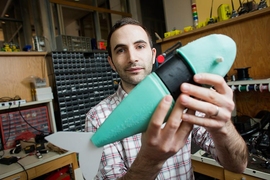
Soft robotic fish moves like the real thing
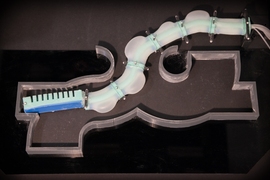
Will tomorrow’s robots move like snakes?
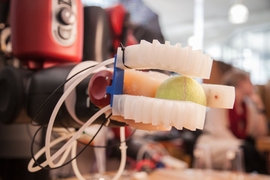
Soft robotic hand can pick up and identify a wide array of objects
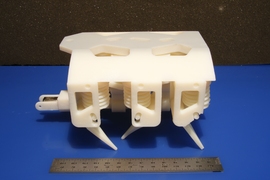
First-ever 3-D printed robots made of both solids and liquids
More mit news.
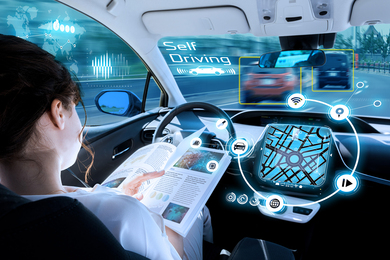
Building an understanding of how drivers interact with emerging vehicle technologies
Read full story →
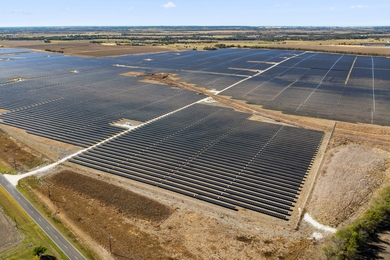
Consortium led by MIT, Harvard University, and Mass General Brigham spurs development of 408 MW of renewable energy

A vision for U.S. science success

MIT researchers develop an efficient way to train more reliable AI agents

Catherine Wolfram: High-energy scholar

Advancing urban tree monitoring with AI-powered digital twins
- More news on MIT News homepage →
Massachusetts Institute of Technology 77 Massachusetts Avenue, Cambridge, MA, USA
- Map (opens in new window)
- Events (opens in new window)
- People (opens in new window)
- Careers (opens in new window)
- Accessibility
- Social Media Hub
- MIT on Facebook
- MIT on YouTube
- MIT on Instagram

Departments
- Applied Physics
- Biomedical Engineering
- Center for Urban Science and Progress
- Chemical and Biomolecular Engineering
- Civil and Urban Engineering
- Computer Science and Engineering
- Electrical and Computer Engineering
- Finance and Risk Engineering
- Mathematics
- Mechanical and Aerospace Engineering
- Technology, Culture and Society
- Technology Management and Innovation
Degrees & Programs
- Bachelor of Science
- Master of Science
- Doctor of Philosophy
- Digital Learning
- Certificate Programs
- NYU Tandon Bridge
- Undergraduate
- Records & Registration
- Digital Learning Services
- Teaching Innovation
- Explore NYU Tandon
- Year in Review
- Strategic Plan
- Diversity & Inclusion
News & Events
- Social Media
Looking for News or Events ?
Press Release
What Makes a Robot Fish Attractive? (Hint: It’s in the Moves)
Through a series of experiments, researchers at NYU-Poly have shown that a biomimetic fish, like this one pictured, is capable of leading a school of live ones.
Probing the largely unexplored question of what characteristics make a leader among schooling fish, researchers have discovered that by mimicking nature, a robotic fish can transform into a leader of live ones.
Through a series of experiments, researchers from Polytechnic Institute of New York University (NYU-Poly) aimed to increase understanding of collective animal behavior, including learning how robots might someday steer fish away from environmental disasters. Nature is a growing source of inspiration for engineers, and the researchers were intrigued to find that their biomimetic robotic fish could not only infiltrate and be accepted by the swimmers, but actually assume a leadership role.
In a paper published online in the Journal of the Royal Society Interface , Stefano Marras, at the time a postdoctoral fellow in mechanical engineering at NYU-Poly and currently a researcher at Italy’s Institute for the Marine and Coastal Environment-National Research Council , and Maurizio Porfiri, NYU-Poly associate professor of mechanical engineering, found conditions that induced golden shiners to follow in the wake of the biomimetic robot fish, taking advantage of the energy savings generated by the robot.
The researchers designed their bio-inspired robotic fish to mimic the tail propulsion of a swimming fish, and conducted experiments at varying tail beat frequencies and flow speeds. In nature, fish positioned at the front of a school beat their tails with greater frequency, creating a wake in which their followers gather. The followers display a notably slower frequency of tail movement, leading researchers to believe that the followers are enjoying a hydrodynamic advantage from the leaders’ efforts.
In an attempt to create a robotic leader, Marras and Porfiri placed their robot in a water tunnel with a golden shiner school. First, they allowed the robot to remain still, and unsurprisingly, the “dummy” fish attracted little attention. When the robot simulated the familiar tail movement of a leader fish, however, members of the school assumed the behavior patterns they exhibit in the wild, slowing their tails and following the robotic leader.
“These experiments may open up new channels for us to explore the possibilities for robotic interactions with live animals — an area that is largely untapped,” explained Porfiri. “By looking to nature to guide our design, and creating robots that tap into animals’ natural cues, we may be able to influence collective animal behavior to aid environmental conservation and disaster recovery efforts.”
The researchers posit that robotic leaders could help lead fish and other wildlife that behave collectively — including birds — away from toxic situations such as oil or chemical spills or human-made dangers such as dams. Other experimenters have found success in prompting wildlife to move using non-living attractants, but the researchers believe this is the first time that anyone has used biomimetics to such effect.
Marras and Porfiri conducted their experiments with support from the National Science Foundation .
About Polytechnic Institute of New York University
Polytechnic Institute of New York University (formerly Polytechnic University), an affiliate of New York University, is a comprehensive school of engineering, applied sciences, technology and research, and is rooted in a 158-year tradition of invention, innovation and entrepreneurship: i2e. The institution, founded in 1854, is the nation’s second-oldest private engineering school. In addition to its main campus in New York City at MetroTech Center in downtown Brooklyn, it also offers programs at sites throughout the region and around the globe. Globally, NYU-Poly has programs in Israel, China and is an integral part of NYU's campus in Abu Dhabi. For more information, visit engineering.nyu.edu .
More to Read
NYU Tandon master’s program in financial engineering earns top marks yet again


Jeffrey Hubbell joins NYU Tandon to lead new university-wide health engineering initiative and expand the School’s bioengineering focus
Real-time video deepfake scams are here. this tool attempts to zap them.
Design, Modeling, and Experiment of Underactuated Flexible Gliding Robotic Fish
Ieee account.
- Change Username/Password
- Update Address
Purchase Details
- Payment Options
- Order History
- View Purchased Documents
Profile Information
- Communications Preferences
- Profession and Education
- Technical Interests
- US & Canada: +1 800 678 4333
- Worldwide: +1 732 981 0060
- Contact & Support
- About IEEE Xplore
- Accessibility
- Terms of Use
- Nondiscrimination Policy
- Privacy & Opting Out of Cookies
A not-for-profit organization, IEEE is the world's largest technical professional organization dedicated to advancing technology for the benefit of humanity. © Copyright 2024 IEEE - All rights reserved. Use of this web site signifies your agreement to the terms and conditions.
Thank you for visiting nature.com. You are using a browser version with limited support for CSS. To obtain the best experience, we recommend you use a more up to date browser (or turn off compatibility mode in Internet Explorer). In the meantime, to ensure continued support, we are displaying the site without styles and JavaScript.
- View all journals
- My Account Login
- Explore content
- About the journal
- Publish with us
- Sign up for alerts
- Open access
- Published: 18 December 2022
Design and control of soft biomimetic pangasius fish robot using fin ray effect and reinforcement learning
- Samuel M. Youssef 1 ,
- MennaAllah Soliman 1 ,
- Mahmood A. Saleh 1 ,
- Ahmed H. Elsayed 2 &
- Ahmed G. Radwan 3 , 4
Scientific Reports volume 12 , Article number: 21861 ( 2022 ) Cite this article
5778 Accesses
11 Citations
7 Altmetric
Metrics details
- Computer science
- Mechanical engineering
Soft robots provide a pathway to accurately mimic biological creatures and be integrated into their environment with minimal invasion or disruption to their ecosystem. These robots made from soft deforming materials possess structural properties and behaviors similar to the bodies and organs of living creatures. However, they are difficult to develop in terms of integrated actuation and sensing, accurate modeling, and precise control. This article presents a soft-rigid hybrid robotic fish inspired by the Pangasius fish. The robot employs a flexible fin ray tail structure driven by a servo motor, to act as the soft body of the robot and provide the undulatory motion to the caudal fin of the fish. To address the modeling and control challenges, reinforcement learning (RL) is proposed as a model-free control strategy for the robot fish to swim and reach a specified target goal. By training and investigating the RL through experiments on real hardware, we illustrate the capability of the fish to learn and achieve the required task.
Similar content being viewed by others
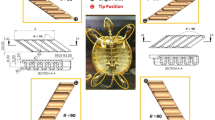
Modelling and implementation of soft bio-mimetic turtle using echo state network and soft pneumatic actuators
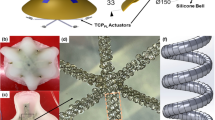
Jelly-Z: swimming performance and analysis of twisted and coiled polymer (TCP) actuated jellyfish soft robot
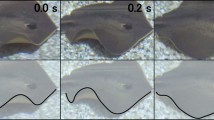
Cartilage structure increases swimming efficiency of underwater robots
Introduction.
Underwater depths have proven to be very challenging environments for humans to venture into. Researchers and engineers strive to build underwater robotic systems to accomplish this dangerous endeavor. From oceanic investigation and marine life exploration to execution of underwater missions and sample gathering to monitoring and maintenance of offshore and underwater structures, many complex tasks need to be done in harsh unpredictable conditions. These aquatic tasks are commonly carried out using underwater vehicles such as remotely operated vehicles (ROVs) and autonomous underwater vehicles (AUVs). However, AUVs are currently limited to mid-depth exploratory operations, while ROVs are more suitable for deep seabed investigation but are constrained by the requirement of tethering and manual piloting. In addition, these systems are mainly made from rigid parts that limit their maneuverability, their ability to safely interact with their surroundings, and their adaptability to the unforeseeable aquatic climate 1 . Leveraging the new technological advancements in biomimetics and soft robotics provides promising solutions to build robotic systems capable of operating more naturally and withstanding these harsh environments 2 , 3 .
Studying the various biological marine creatures offers insights into the characteristics allowing them to live in and populate vast oceanic regions. Taking inspiration from the morphologies of underwater living organisms, their techniques for swimming and locomotion, and their sensory capabilities aids in the development of bioinspired robotic systems similar to these creatures, making these robots more suitable for underwater applications. Swimming motion amongst underwater creatures shows a variety of locomotion techniques, guided by the morphological structures and shapes of such creatures 4 . The majority of aquatic creatures possess compliant bodies and rely on their body deformation to generate the thrust needed for locomotion. The most common classification of fish swimming motion has been adopted according to fish anatomy and their propulsors 5 . By moving their body and fins with different undulating or oscillatory frequencies, fish can generate the thrust needed for forward motion, turning, and escape maneuvers. While this classification is mainly concerned with fish and batoids swimming, other marine creatures such as jellyfish, turtles, echinoderms, and crustaceans use different types of locomotion like jet propulsion, drag-induced swimming, and crawling. In addition, several studies focused on fish’s individual and group behaviors, and their social interactions with biomimetic fish robots 6 , 7 , 8 , 9 , 10 . These investigations provide insight into the use of fish-like robots to interact with and study fish behavior, and mechanisms responsible for mixed phenotype aggregations, as well as, provide biohybrid stimuli for further social analysis such as anxiety treatment and information transfer.
The field of soft robotics offers successful approaches for building bioinspired robotic systems in general 11 , 12 , 13 , 14 , and more specifically robots inspired by biological marine creatures 15 . The use of soft materials to develop robots with compliant bodies and large degrees of freedom can take us a step closer to mimicking marine creatures with complex locomotion 16 . Several attempts have been made to exploit their deformability to design biomimetic soft robots capable of imitating biological swimming motion 17 . One approach made use of hydraulic elastomers to develop a soft robotic fish capable of performing several swimming maneuvers 2 . Alternatively, a bioinspired robotic fish uses ionic polymer-metal composite (IPMC) actuators as the pectoral and caudal fins 18 . Another team was able to mimic the cephalopod molluscs by using hydraulic smart soft bending actuators to build the tentacles that aid the cephalopod in maneuvering 19 . A brittle star-inspired soft robot uses twenty shape memory alloy (SMA) wires to actuate five flexible legs and perform underwater crawling 20 . A robotic jellyfish uses the fin ray structure to mimic the soft tentacles of the jellyfish and their motion 21 . Some of these soft robots were tested in real underwater environments, such as the snailfish robot actuated using dielectric elastomers (DEs), which was able to operate at great depths 3 .
One of the biggest challenges in soft robotics is the modeling and control of these non-linear complex systems 22 . Research has been tackling these challenges using various approaches 23 . Some approaches rely on model-based control techniques, however, developing these techniques has proven to be a difficult task due to the complexity of developing models for high-dimensional soft robotic systems 24 . Several modeling theories, approximation models, and dimensionality reduction techniques are proposed to simplify the modeling task. By contrast, model-free control does not require a model or prior information about the system but relies mainly on the input-output behavior collected directly from the system to learn an approximate representation of it. Reinforcement learning (RL) is one of these model-free control techniques that have been providing promising results in recent years 25 . RL is a data-driven learning process that depends on having the agent interact with its environment by taking certain actions and observing its new state. The agent is then given a reward based on the task it needs to complete and the RL algorithm learns a policy to map the state-action pairs.
In particular, RL has been implemented for soft robotics control in general and specifically in the case of underwater soft robotics 26 . One group used a Q-learning algorithm with experience replay to maximize the swimming speed of a cuttlefish soft robot actuated by a DE membrane 27 . Soft actor-critic (SAC) was also used to learn a control strategy for a robotic eel with compliant bodies to allow it to swim efficiently in a straight line 28 . SMAs were also used to actuate a soft robot by employing Q-learning to develop a control policy for end effector locomotion 29 . Additionally, an octopus-inspired soft robot used deep q learning (DQN) to control the posture of the soft arms of the robot 30 . One approach used a deep deterministic policy gradient (DDPG) algorithm to learn a control policy for soft continuum arms 31 . However, training RL agents is a costly process in terms of computation time and resources, and it becomes more complex for soft robots due to their non-linear dynamics and elastic properties. To solve this problem, a research group implemented an RL method that ignores the soft materials’ properties and structure of the robot, and it was applied to the Honeycomb PneuNets soft robot 32 . A different technique to simplify the RL process is the use of learning from demonstration (LfD) and imitation learning methods, such as in the case of the STIFF-FLOP robotic arm 33 , where the movement patterns of an octopus arm were transferred to the robot arm as a guide to speed up the learning process. Combining a model with RL algorithms could help the policy learning process. One research proposes a model-based RL for closed-loop control of soft robotic manipulators 34 . The proposed approach uses a recurrent neural network (RNN) to learn the forward dynamic model, which is then used to develop a closed-loop predictive controller. The mentioned studies investigated the use of different RL algorithms for soft robotics control, including combining it with imitation learning. However, the success of RL in high-level tasks of soft robots like underwater navigation is still a question. In addition, comparisons between several RL algorithms’ performances for the same task have not been discussed.
In this paper, we propose a design for a biomimetic fish robot inspired by the Pangasius fish, using the fin ray effect (FRE) for soft body actuation to mimic the fish’s body and tail undulation (Fig. 1 ). We investigate the use of three RL algorithms to teach the robot to swim to a specific goal. By achieving the task of underwater navigation and reaching target goals, the biomimetic robot fish developed in this work could be integrated into actual aquatic environments in the future. The main application of such robots is performing underwater exploration, researching marine life, monitoring coral reefs, and gathering samples without disturbing or destroying the environment. Such research is important to study the change in the underwater ecological system and the effect of climate change on it, giving insight into the needed actions to mitigate this effect.

Soft biomimetic Pangasius fish robot. Robot prototype (left). Complete CAD of the robot (right).
Materials and methods
Pangasius fish morphological analysis.
To build a soft underwater robot that mimics fish locomotion, an actual fish is studied through visual motion analysis to obtain insight and parameters relevant to the design and control of the equivalent biomimetic fish robot. The Pangasius fish was recorded using a webcam over several periods to obtain videos of its swimming motion. There are two main approaches to performing motion capture and tracking, marker-based and markerless tracking 35 . The traditional marker-based methods rely on having markers at the different points that will be tracked. These markers could be retro-reflective parts attached to the subject being tracked or differently colored parts, or in some cases, inertial measurement units are embedded and their data help estimate the motion of certain points. Such methods require hardware preparations but no further annotations are needed. On the other hand, The markerless tracking methods depend on having labeled ground truth done by humans, then machine learning models such as convolutional neural networks (CNNs) and residual networks (ResNets) are trained to estimate the motion based on the labeled keypoints.
To perform motion analysis for this experiment, the markerless approach was used by preparing a motion capture setup. It is comprised of a water tank of dimensions 120 \(\times\) 70 cm. The fish recorded for the analysis is from the Pangasius genus, a freshwater class of medium to very large shark catfishes. The dimensions of the fish in the study are roughly 21 cm in total body length, 2.5 cm in width, and 1.5 cm of head length “Lf” 36 . The fish has seven fins across its body, as shown in Fig. 2 , two pectoral fins, a dorsal fin, a pelvis fin, an anal fin, an adipose fin, and a caudal fin at its tail end 37 . The data acquisition is carried through a Logitech C920 visual monocular camera. The camera was mounted on top of the tank to provide a full top view of the tank’s area. Video streams of the fish’s swimming sequence were captured at 30 frames per second (fps) using the camera.

Real Pangasius fish anatomy captured by image processing motion system that presents the real dimension and morphological structure for the fish.
Pose estimation
Studying the swimming patterns and motion of the fish requires performing pose estimation on the recorded video data to track the deformation and motion of the fish’s different body parts during its swimming sequences. The pose estimation step was performed using DeepLabCut, a deep learning platform for markerless animal pose estimation 38 .
During the pose estimation process (Fig. 3 ), three body parts of the fish are defined to be tracked: the head, the center of the pectoral fins, and the caudal fin. Several samples were taken from the captured videos and annotated with the body parts. A ResNet neural network with 152 layers is trained using the video streams to estimate the position of these points. The network was trained for 200,000 epochs reaching training and testing errors of approximately 3 and 6 pixels, respectively.
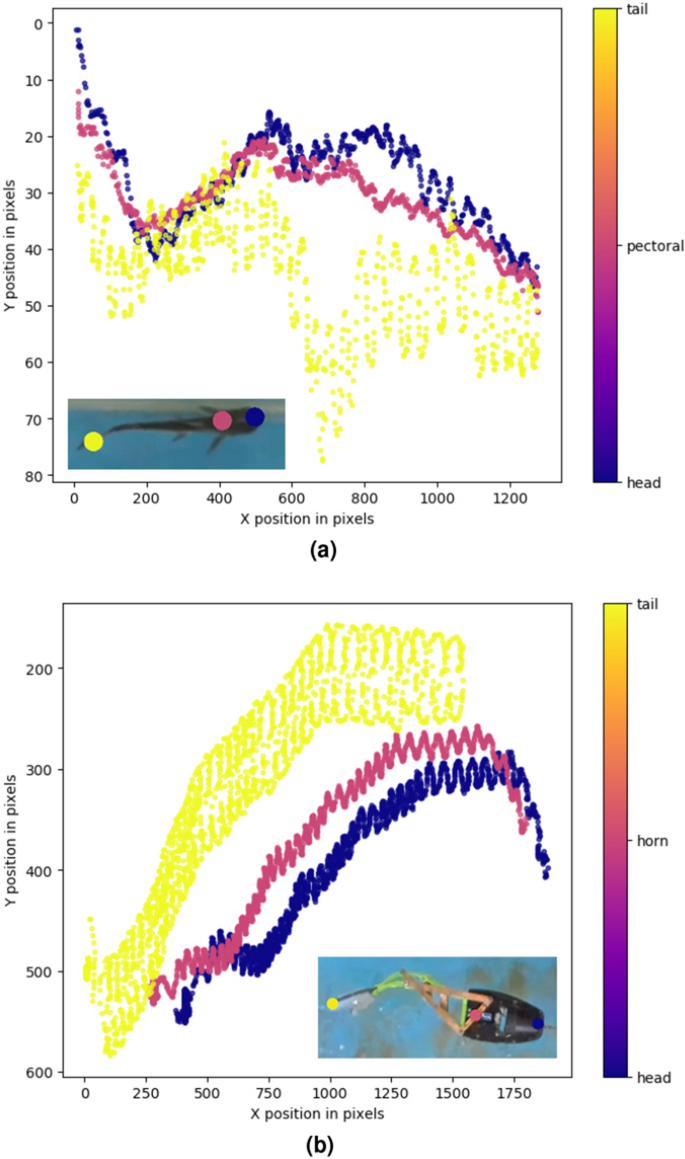
Results of the pose estimation and trajectory plot for both the fish and the robot. ( a ) Fish pose estimation. ( b ) Robot pose estimation.
Swimming analysis
After obtaining the positions of the needed body parts, further analysis is conducted on the predicted pose of the fish to investigate the important parameters responsible for the swimming motion of the fish, which should help design the biomimetic fish. Such crucial parameters include the fish’s tail frequency and amplitude, and the resulting velocity at which the fish can swim due to its undulating motion. During carangiform swimming, the locomotion relies mostly on the undulation motion of the body and caudal fin, while the pectoral, pelvic, and dorsal fins help the fish balance and swim up and down.
By analyzing several sample videos of the fish’s swimming, the tracking of the tail’s motion allows us to obtain the undulation frequency of the fish’s body. While stationary, the frequency of the tail ranged from 0.7 to 2 hertz (Hz). During low-speed swimming, the frequency ranged from 1 to 2.5 Hz, while it reached up to 4.5 Hz during high-speed swimming. The attained speed during low-speed swimming was in the range of 5–6 cm/s, and up to 65 cm/s for high-speed swimming.
Soft-rigid biomimetic pangasius fish robot design and prototyping
The soft-rigid biomimetic Pangasius fish is designed based on the dimensions of the real fish that is captured using the vision system, as described previously. The robot’s dimensions are scaled to double the dimensions of the real fish. The design is distributed into three main parts: fish rigid head, fish flexible tail, and caudal fin, as shown in Fig. 4 . The fish’s body is responsible for the undulatory motion needed to move in the water. A soft tail is designed to mimic the fish’s tail and its motion, based on the fin ray effect (FRE), which is inspired by the tail fins of fish, making it a suitable option to provide similar swimming motion 39 . The fin ray compliant structure is chosen due to its high similarity to the naturally efficient bony tail of the fish. The actuator relies on a simple compressive force that causes the fin ray to bend in the direction of the force, deforming the tail into a concave shape that encloses a large volume of water and then accelerates it toward the rear. This motion results in a highly efficient forward thrust of the robot, analogous to fish swimming.
The fin ray consists of a flexible outer body, rigid links between its segmentation, and rigid connections between the servo motor (the source of actuation) and the actuating points in the fin ray itself. The actuation is driven by a waterproof servo motor that applies force to the sides of the fin ray making it bend in the direction of the force. By rotating in an oscillatory motion, the servo applies force on both sides of the actuator, working as an underactuated mechanism and resulting in the needed undulatory motion. However, the limited torque of the actuation servo motor makes it hard to generate enough thrust to perform fast maneuvers and the possible tail beat frequencies are also limited by the servo’s speed. In addition, the absence of pectoral fins on the robot limits the ability to swim with stable forward motion.
Different manufacturing techniques based on additive manufacturing are followed to produce the biomimetic Pangasius robot 40 . Due to the high complexity of the fish head part, selective laser sintering (SLS) is selected for production using the Sinterit Lisa Pro. The material used for SLS printing is PA12 Smooth, a Nylon-based material that is selected for its high durability. For the flexible fin ray, a high hyperelastic material is needed for its construction due to the low complexity of the design. The fused deposition modeling (FDM) 3D printer is selected to manufacture this part using the Felix 4Tec with a flexible material: the Extrudr FLEX medium material. Finally, a high-rigidity material is needed for rigid links and rigid connectors to withstand the tension forces exerted by the servo motor. The material being used is a glass-reinforced epoxy laminate material (FR-4) and is cut through a CO2 laser machine.
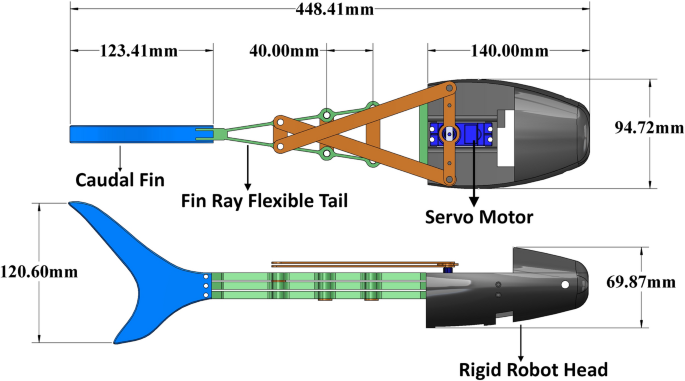
Detailed design and dimensions of robot design with an approximate double scale of real fish dimensions.
The robot’s swimming is achieved mainly through the undulation of the soft fin ray tail. By keeping the frequency of the undulation constant, the robot is able to swim forward, and depending on whether the frequency is low or high would make the robot swim slower or faster, respectively. However, performing a sequence of different frequencies in succession would cause the fish to change direction. In addition, the effect of the fluid perturbation and its interaction with the robot also affects its swimming. The robot’s swimming performance is assessed using the same method as the fish. By tracking the robot’s head and tail, the swimming speed and the tail beat frequency are obtained. We observe that the relation between the robot’s swimming speed, represented as the fish’s body length per second (BL/s), and its tail beat frequency (Hz) is similar to a second-order polynomial, as shown in Fig. 5 . By applying Fourier transform to the robot’s tail motion at various speeds, the dominant undulatory swimming frequencies of the robot can be seen in Fig. 6 .
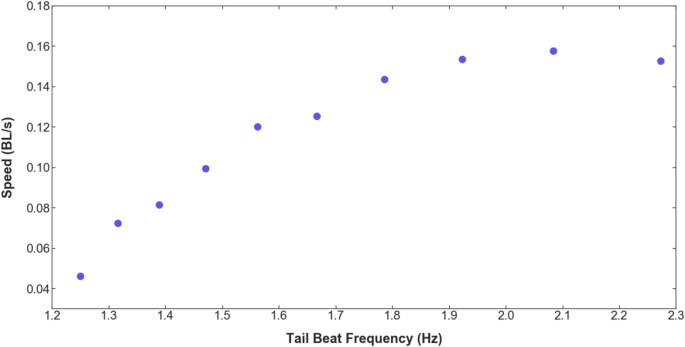
Robot’s swimming speed versus tail beat frequency.
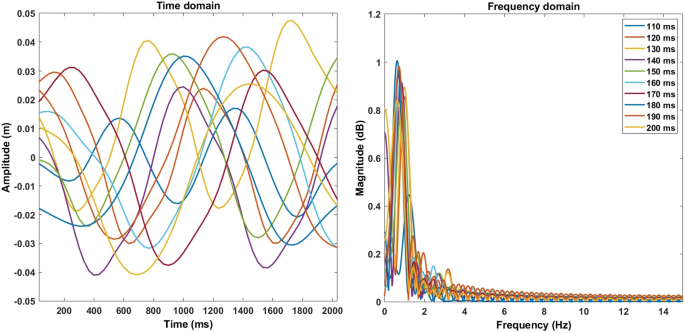
Time domain and frequency domain analysis of the swimming speeds of the robot. Each signal represents a swimming speed defined by the time to perform a single tail stroke in ms, ranging from 110 to 200 ms. The time domain shows the amplitudes of the tail’s undulatory motion, while the frequency domain shows the dominant frequency at each speed.
Comparing the fish’s swimming to the robot’s shows the similarity between their tail beat frequencies at slow and fast swimming, shown in Fig. 7 . The robot’s tail oscillation amplitude is scaled by the ratio between the robot and fish dimensions, to take into account the difference in their bodies’ deflections. The robot’s tail beat frequencies were chosen to be within the same range of the fish’s slow swimming, from 1 to 2.5 Hz. In addition, the cost of transport (COT) of the robot was calculated as an indication of its locomotion efficiency. COT is defined as the energy required to move a unit mass a unit distance 41 , according to the following equation:
where E is the robot’s input energy, m is the robot’s mass (0.422 kg), g is the gravitational acceleration (9.8 m/s \(^2\) ), d is the travel distance (m), P is the robot’s power in terms of input voltage (12 V) and input current (2 A), and v is the robot’s velocity (between 0.02 and 0.06 m/s). Through trials, the COT for the robot is measured between 95 and 315 for different tail frequencies and robot velocities, with the best COT being at the highest velocity of 6 cm/s and the highest tail beat frequency of 2.3 Hz, indicating more efficient swimming and COT at higher swimming speeds.
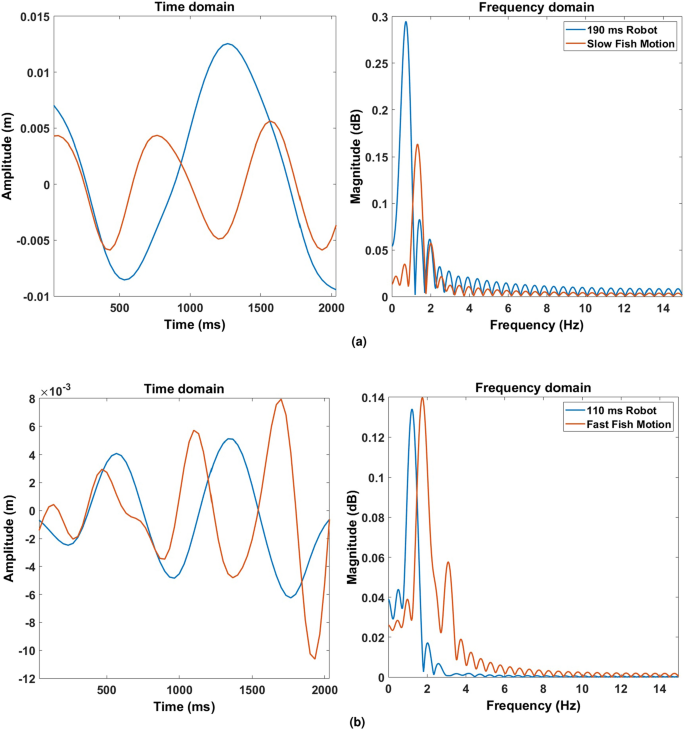
Comparison between the fish and robot tail beat frequencies. ( a ) Frequencies during slow swimming (robot’s tail stroke time at 190 ms). ( b ) Frequencies during fast swimming (robot’s tail stroke time at 110 ms).
Reinforcement learning (RL)
The main objective of this experiment is to make the robot swim to a certain predetermined goal location in the tank. The setup is shown in Fig. 8 . The tank and robot are monitored using a Logitech Brio camera at 60 fps that captures the environment and feeds the frames to DeepLabCut to perform pose estimation. The trained neural network was able to provide accurate pose estimation of the robot with minimal pose loss after the training. In addition, the high capture rate of 60 fps compared to the slow swimming motion of the robot allows the neglect of pose point loss of some frames during the RL training. Moreover, the network outputs a likelihood of the prediction, which gives an indication of occlusion or pose loss of the tracked points. If the likelihood value of a pose point prediction is lower than a certain threshold during the current frame, this pose is discarded and the last known pose with likelihood above the threshold is kept. The likelihood threshold chosen during the RL training is 0.8.
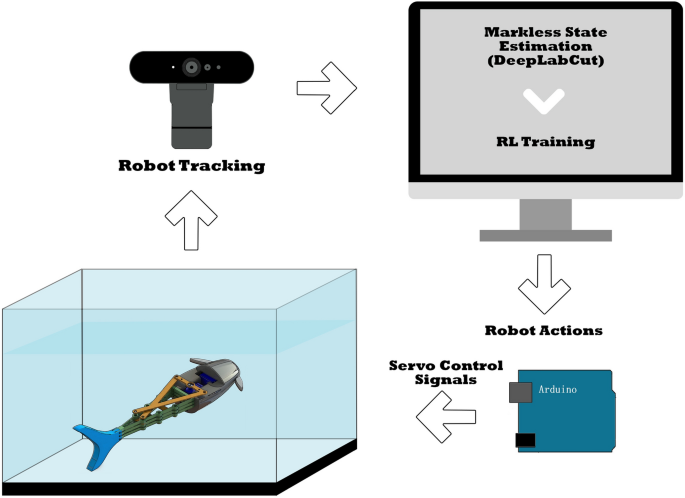
Schematic of the experiment setup.
To perform RL training, generally, simulation tools are first used to train the agent, then the learning is transferred to the actual robot. However, due to the complexity of simulating soft materials that exhibit high deformation and the fluid-structure interaction between the robot and environment, the RL training algorithm was implemented directly on the experimental setup. By using stable baselines 3 42 on top of OpenAI Gym 43 , the RL environment is built by defining the observation and action spaces for the agent.
The actual possible actions for the robot could be described as a continuous space of varying servo speeds and angles, up to the maximum values according to the servo’s specifications. However, having a continuous action space could make the problem more complex to solve for the RL algorithm. Hence, the discretization of the actions would help simplify the task. Thus, the oscillation of the servo is fixed as the maximum travel of the servo, which is \(130^\circ\) according to the manufacturer’s specifications. The servo oscillation speed becomes the only variable for the actions. By using the fish swimming analysis as a base, several oscillatory frequencies of the tail were chosen to be applied as the varying speed of the actuation servo motor. These speeds comprise the action space of the robot. A total of 10 actions are defined, ranging between 110 and 200 milliseconds (ms) to perform a tail stroke, with a 10 ms step.
The observation space is comprised of several parameters related to the robot and its environment. First, the x and y positions are obtained from the state estimation performed through DeepLabCut for 3 points on the robot: the head, the servo horn, and the tail. The distances in the x and y directions between the robot’s head and the destined goal point are also added. Finally, a queue of previous actions is appended to the state.
where s is the observation space. \(p_1(x, y), p_2(x, y), p_3(x,y)\) are the x and y coordinates for the head, servo horn, and tail at step t , respectively. \(\delta x\) and \(\delta y\) are the x and y distances between the robot’s head point and the current goal. a is the action space consisting of 10 actions from 0 to 9, corresponding to the servo speed ranging from 110 to 200 ms, with an increment of 10 ms. k is taken as 100, which is the predefined maximum episode length for this experiment.
Two goals are defined at the two ends of the tank. The robot’s task is to reach the current goal, then the goal changes to the other end once the robot succeeds. To simplify the task, an error tolerance is defined and the robot is considered successful in reaching the target if it swims within a distance of 50 pixels away from the target. The reward function r defined to achieve the task is:
where the reward is the exponential of the euclidean distance dist between the robot’s head point and the goal, and a penalty term as a factor of the distance and the episode step i . \(\beta\) is a reward decay factor, \(\alpha\) is a reward multiplier, and \(\phi\) is a penalty factor. An additional reward is added when the robot reaches the goal point. Since the only terminal state for an episode is reaching the goal with no specific failure state, a maximum limit for steps per episode is defined and the penalty applied to the reward relied on the number of steps elapsed during the episode, increasing as the episode goes longer. The steps limit and the variable factors in the reward function were chosen by trial. Maximum steps per episode, \(\alpha\) , \(\beta\) , \(\phi\) , and goal reward are set as 100, 10, 200, \(10^{-5}\) , and 200, respectively.
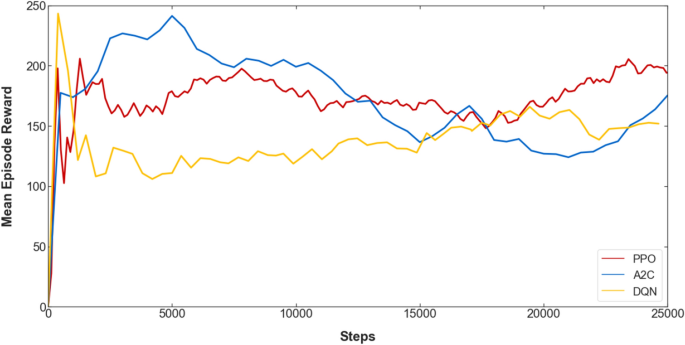
Mean episode reward during the initial training of the three algorithms for 25,000 steps.
To train the robot, three RL algorithms are used to compare their performances. The first two are on-policy algorithms: proximal policy optimization (PPO) 44 and advantage actor-critic (A2C) 45 , which are policy-gradient methods. The third one is the deep q-network (DQN) 46 , an off-policy value-based method. Performing training on the actual robot is affected by the hardware limitation, such as the durability of the materials used and the inability to operate the servo motor for long periods. Thus, the training was conducted for limited periods, as each algorithm was trained for about 25,000 steps to compare their performance. The mean reward per episode for the three algorithms during the initial training steps is shown in Fig. 9 . We can observe that the reward and the robot’s behavior during this initial training are more consistent using PPO, compared to A2C and DQN. Taking into account these results, the PPO algorithm is chosen to be used for further training. Three PPO agents with different random seeds were trained for about 50,000 steps each, with training parameters as shown in Table 1 . The agents’ mean episode reward and losses during training are shown in Fig. 10 .

Mean episode reward, and value and policy gradient losses during training of the three PPO agents for 50,000 steps.
The best agent is tested on the task to reach the goal within the least amount of steps. Figure 11 shows the path and actuation oscillation frequencies taken by the robot to reach the two defined goals. During the test, the robot starts at a random location in the tank and swims toward the target goal 1. Reaching the first goal rewards the robot and changes the target to goal 2. The robot can change direction and swim toward the second goal, getting another reward and ending the test episode. The robot is considered successful in reaching the target goal if it’s within a 50 pixels distance of it, which is about \(95\%\) accuracy.
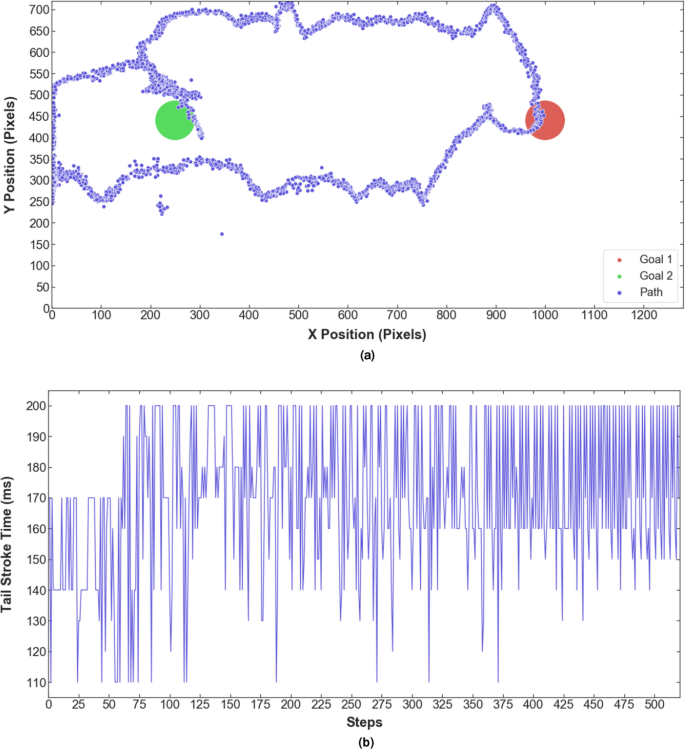
Results of the test run. ( a ) The path taken by the robot to reach the two goals. ( b ) The sequence of actions represented as varying tail stroke time by changing the servo speed.
Developing control algorithms for underwater soft robotics systems is a challenging task due to the non-linear soft body dynamics and the complexity of the fluid-structure interaction in underwater environments. This work explored the use of reinforcement learning as a model-free approach to learning a control policy for a soft-rigid hybrid biomimetic robotic fish. Table 2 shows a comparison between our work and other papers in the literature in terms of modeling and control of soft underwater robots.
In this work, one of the main challenges was running the RL training directly on the robotic hardware. The number of training episodes and the possibility to train multiple agents becomes limited as the training is time-consuming and affects the lifespan, durability, and properties of the soft material, changing its behavior with time. One solution would be the development of an appropriate physics simulator capable of simulating and performing RL on multi-body soft robots in underwater environments, then optimizing the learning through sim2real techniques. Some studies already worked on using accelerated simulators and computational design synthesis to jointly co-optimize the design and control of soft robots 55 , developing data-driven sim2real techniques 56 , or developing spatial and shape grammar in conjunction with using RL and optimization algorithms to co-design morphology and actuation 57 , 58 . These advances in soft robotics simulation would help advance and improve the training process of soft robots’ RL agents. Another potential solution would be through leveraging the advantages of both model-based and model-free techniques to achieve combined hybrid control techniques with better accuracy and efficiency 59 . Another limitation of this work lies in the actuation method that uses a servo motor to achieve soft body deformation. It introduces a rigid component of significant size in the robot, affecting its softness, and limiting the types of maneuvers it can perform and how it can adapt to its environment. Other types of actuation such as artificial muscles made from dielectric materials or microfluidic actuators could help build more efficient soft biohybrid swimmers 60 , 61 .
Finally, we believe that solving the control problem in soft robotics comes hand in hand with solving the modeling problem while considering the high dimensionality of these models and their applicability in real-time control. Promising approaches include the exploitation of the robot’s softness through embodied intelligence and morphological computation, the use of reduced-order models alongside robust control, and infinite dimensional control 24 .
In conclusion, this paper proposed a design for a biomimetic robotic fish with a compliant tail inspired by the Pangasius fish. The robot utilizes a fin ray structure that is made from soft elastic materials and is actuated by a servo motor. The deformation of the soft fin ray tail of the robot fish mimics the undulatory motion of the Pangasius fish during carangiform swimming. The varying undulation frequency of the tail allows the robot to perform underwater locomotion similar to the actual fish. We also investigate the possibility of learning a control policy to teach the robot a certain task, which is reaching a specific target goal in this case. By using reinforcement learning (RL), the robot was able to learn to reach two different goals at opposite locations in the tank. Training the RL algorithm directly on the real prototype eliminates the need to use any sim2real transfer methods. Despite the complexity of the soft robot dynamics, the fluid–structure interaction, and the hydrodynamic forces, the learning process provides good results for the specified task. Training the agent for more steps would possibly allow it to exploit the environment more and learn more complex swimming behavior.
We believe that RL could be similarly implemented on a soft robot with embedded soft actuators, as it has no previous knowledge or model of the system. Changing the actuation method to a soft actuator would change the formulation of the action space. Assuming the consistent performance of the actuator to provide the intended actuation behavior, the RL algorithm should be able to learn a control policy, as has been shown previously in the literature. Further investigation with different actuation and soft robotic systems is intended as the next step.
In future work, we will build on the current advances working to incorporate differentiable simulation and neural network hydrodynamic simulation to allow RL training in simulation and then apply sim2real transfer techniques.
No experiments were conducted on the real fish described in the paper, it was only recorded using a Logitech C920 visual monocular camera. It was tracked using a markerless tracking approach based on deep learning computer vision through the animal behavioral analysis library DeepLabCut, as described in the “Pose Estimation” section.
Data availability
All data generated or analyzed during this study are included in this published article [and its supplementary information files].
Aracri, S. et al. Soft robots for ocean exploration and offshore operations: A perspective. Soft Robot. 20 , 20 (2021).
Google Scholar
Katzschmann, R. K., DelPreto, J., MacCurdy, R. & Rus, D. Exploration of underwater life with an acoustically controlled soft robotic fish. Sci. Robot. 3 , 14 (2018).
Article Google Scholar
Li, G. et al. Self-powered soft robot in the mariana trench. Nature 591 , 66–71 (2021).
Article ADS CAS Google Scholar
Maddock, L. et al. The Mechanics and Physiology of Animal Swimming (Cambridge University Press, ***, 1994).
Book Google Scholar
Sfakiotakis, M., Lane, D. M. & Davies, J. B. C. Review of fish swimming modes for aquatic locomotion. IEEE J. Ocean. Eng. 24 , 237–252 (1999).
Article ADS Google Scholar
Romano, D. & Stefanini, C. Robot–fish interaction helps to trigger social buffering in neon tetras: The potential role of social robotics in treating anxiety. Int. J. Soc. Robot. 14 , 963–972 (2022).
Romano, D. & Stefanini, C. Individual neon tetras (paracheirodon innesi, myers) optimise their position in the group depending on external selective contexts: Lesson learned from a fish-robot hybrid school. Biosyst. Eng. 204 , 170–180 (2021).
Article CAS Google Scholar
Romano, D. & Stefanini, C. Any colour you like: Fish interacting with bioinspired robots unravel mechanisms promoting mixed phenotype aggregations. Bioinspir. Biomimetics 20 , 20 (2022).
Worm, M., Landgraf, T. & von der Emde, G. Electric signal synchronization as a behavioural strategy to generate social attention in small groups of mormyrid weakly electric fish and a mobile fish robot. Biol. Cybern. 20 , 1–15 (2021).
MATH Google Scholar
Brown, A. A., Brown, M. F., Folk, S. R. & Utter, B. A. Archerfish respond to a hunting robotic conspecific. Biol. Cybern. 115 , 585–598 (2021).
Article MATH Google Scholar
Kim, S., Laschi, C. & Trimmer, B. Soft robotics: A bioinspired evolution in robotics. Trends Biotechnol. 31 , 287–294 (2013).
Shepherd, R. F. et al. Multigait soft robot. Proc. Natl. Acad. Sci. 108 , 20400–20403 (2011).
Lin, H.-T., Leisk, G. G. & Trimmer, B. Goqbot: A caterpillar-inspired soft-bodied rolling robot. Bioinspir. Biomimetics 6 , 026007 (2011).
Soliman, M., Mousa, M. A., Saleh, M. A., Elsamanty, M. & Radwan, A. G. Modelling and implementation of soft bio-mimetic turtle using echo state network and soft pneumatic actuators. Sci. Rep. 11 , 1–11 (2021).
Youssef, S. M. et al. Underwater soft robotics: A review of bioinspiration in design, actuation, modeling, and control. Micromachines 13 , 110 (2022).
Hermes, M., Ishida, M., Luhar, M. & Tolley, M. T. Bioinspired shape-changing soft robots for underwater locomotion: Actuation and optimization for crawling and swimming. Bioinspired Sens. Actuation Control Underwater Soft Robot. Syst. 20 , 7–39 (2021).
Ming, A. & Zhao, W. Design of biomimetic soft underwater robots. In Mechatronic Futures 91–111 (Springer, ***, 2016).
Yang, T. & Chen, Z. Development of 2d maneuverable robotic fish propelled by multiple ionic polymer-metal composite artificial fins. In 2015 IEEE International Conference on Robotics and Biomimetics (ROBIO) , 255–260 (IEEE, 2015).
Shen, Z., Na, J. & Wang, Z. A biomimetic underwater soft robot inspired by cephalopod mollusc. IEEE Robot. Autom. Lett. 2 , 2217–2223 (2017).
Patterson, Z. J., Sabelhaus, A. P., Chin, K., Hellebrekers, T. & Majidi, C. An untethered brittle star-inspired soft robot for closed-loop underwater locomotion. In 2020 IEEE/RSJ International Conference on Intelligent Robots and Systems (IROS) , 8758–8764 (IEEE, 2020).
Gatto, V. L., Rossiter, J. M. & Hauser, H. Robotic jellyfish actuated by soft finray effect structured tentacles. In 2020 3rd IEEE International Conference on Soft Robotics (RoboSoft) , 144–149 (IEEE, 2020).
Rus, D. & Tolley, M. T. Design, fabrication and control of soft robots. Nature 521 , 467–475 (2015).
George Thuruthel, T., Ansari, Y., Falotico, E. & Laschi, C. Control strategies for soft robotic manipulators: A survey. Soft Robot. 5 , 149–163 (2018).
Della Santina, C., Duriez, C. & Rus, D. Model based control of soft robots: A survey of the state of the art and open challenges. arXiv:2110.01358 (arXiv preprint) (2021).
Sutton, R. S. & Barto, A. G. Reinforcement Learning: An Introduction (MIT press, ***, 2018).
Bhagat, S., Banerjee, H., Ho Tse, Z. T. & Ren, H. Deep reinforcement learning for soft, flexible robots: Brief review with impending challenges. Robotics 8 , 4 (2019).
Yang, T. et al. A soft artificial muscle driven robot with reinforcement learning. Sci. Rep. 8 , 1–8 (2018).
ADS Google Scholar
Wang, Q., Hong, Z. & Zhong, Y. Learn to swim: Online motion control of an underactuated robotic eel based on deep reinforcement learning. Biomimetic Intell. Robot. 2 , 100066 (2022).
Liu, W. et al. Distance-directed target searching for a deep visual servo sma driven soft robot using reinforcement learning. J. Bionic Eng. 17 , 1126–1138 (2020).
Wu, Q. et al. Bipedal walking of underwater soft robot based on data-driven model inspired by octopus. Front. Robot. AI 9 , 25 (2022).
Satheeshbabu, S., Uppalapati, N. K., Fu, T. & Krishnan, G. Continuous control of a soft continuum arm using deep reinforcement learning. In 2020 3rd IEEE International Conference on Soft Robotics (RoboSoft) , 497–503 (IEEE, 2020).
Zhang, H., Cao, R., Zilberstein, S., Wu, F. & Chen, X. Toward effective soft robot control via reinforcement learning. In International Conference on Intelligent Robotics and Applications , 173–184 (Springer, 2017).
Malekzadeh, M. S., Calinon, S., Bruno, D. & Caldwell, D. G. Learning by imitation with the stiff-flop surgical robot: A biomimetic approach inspired by octopus movements. Robot. Biomimetics 1 , 1–15 (2014).
Thuruthel, T. G., Falotico, E., Renda, F. & Laschi, C. Model-based reinforcement learning for closed-loop dynamic control of soft robotic manipulators. IEEE Trans. Robot. 35 , 124–134 (2018).
Mathis, A., Schneider, S., Lauer, J. & Mathis, M. W. A primer on motion capture with deep learning: Principles, pitfalls, and perspectives. Neuron 108 , 44–65 (2020).
Abbaspour, M. & Vaghefi, A. Experimental hydrodynamics imaging and undulatory movement equation of steady swimming fish ( Pangasius sanitwongsei ). WIT Trans. Ecol. Environ. 160 , 171–181 (2012).
Sahu, B. et al. Carcass traits of two marketable size classes of Pangasius pangasius (Hamilton, 1822). J. Appl. Ichthyol. 29 , 226–229 (2013).
Mathis, A. et al. Deeplabcut: Markerless pose estimation of user-defined body parts with deep learning. Nat. Neurosci. 20 , 20 (2018).
Bannasch, R. & Kniese, L. Manipulator tool and holding and/or expanding tool with at least one manipulator tool (2012). US Patent 8,333,417.
Yap, Y. L., Sing, S. L. & Yeong, W. Y. A review of 3d printing processes and materials for soft robotics. Rapid Prototyping J. 20 , 20 (2020).
Christianson, C. et al. Jellyfish-inspired soft robot driven by fluid electrode dielectric organic robotic actuators. Front. Robot. AI 6 , 126 (2019).
Raffin, A. et al. Stable-baselines3: Reliable reinforcement learning implementations. J. Mach. Learn. Res. 22 , 1–8 (2021).
Brockman, G. et al. Openai gym (2016). arXiv:1606.01540 .
Schulman, J., Wolski, F., Dhariwal, P., Radford, A. & Klimov, O. Proximal policy optimization algorithms. arXiv:1707.06347 (arXiv preprint) (2017).
Mnih, V. et al. Asynchronous methods for deep reinforcement learning. In International Conference on Machine Learning , 1928–1937 (PMLR, 2016).
Mnih, V. et al. Human-level control through deep reinforcement learning. Nature 518 , 529–533 (2015).
Kopman, V., Laut, J., Acquaviva, F., Rizzo, A. & Porfiri, M. Dynamic modeling of a robotic fish propelled by a compliant tail. IEEE J. Ocean. Eng. 40 , 209–221 (2014).
El Daou, H., Salumäe, T., Chambers, L. D., Megill, W. M. & Kruusmaa, M. Modelling of a biologically inspired robotic fish driven by compliant parts. Bioinspir. Biomimetics 9 , 016010 (2014).
Renda, F., Giorgio-Serchi, F., Boyer, F. & Laschi, C. Modelling cephalopod-inspired pulsed-jet locomotion for underwater soft robots. Bioinspir. Biomimetics 10 , 055005 (2015).
Wang, J., McKinley, P. K. & Tan, X. Dynamic modeling of robotic fish with a base-actuated flexible tail. J. Dyn. Syst. Meas. Control 137 , 25 (2015).
Zhong, Y., Li, Z. & Du, R. A novel robot fish with wire-driven active body and compliant tail. IEEE/ASME Trans. Mechatron. 22 , 1633–1643 (2017).
Lin, Y.-H. et al. Modeling and control of a soft robotic fish with integrated soft sensing. Adv. Intell. Syst. 20 , 2000244 (2021).
Huang, W., Patterson, Z., Majidi, C. & Jawed, M. K. Modeling soft swimming robots using discrete elastic rod method. In Bioinspired Sensing, Actuation, and Control in Underwater Soft Robotic Systems 247–259 (Springer, ***, 2021).
Chapter Google Scholar
Obayashi, N., Bosio, C. & Hughes, J. Soft passive swimmer optimization: From simulation to reality using data-driven transformation. In 2022 IEEE 5th International Conference on Soft Robotics (RoboSoft) , 328–333 (IEEE, 2022).
Ma, P. et al. Diffaqua: A differentiable computational design pipeline for soft underwater swimmers with shape interpolation. ACM Trans. Graph. 40 , 1–14 (2021).
Du, T., Hughes, J., Wah, S., Matusik, W. & Rus, D. Underwater soft robot modeling and control with differentiable simulation. IEEE Robot. Autom. Lett. 6 , 4994–5001 (2021).
Van Diepen, M. & Shea, K. A spatial grammar method for the computational design synthesis of virtual soft locomotion robots. J. Mech. Des. 141 , 25 (2019).
van Diepen, M. & Shea, K. Co-design of the morphology and actuation of soft robots for locomotion. J. Mech. Des. 144 , 083305 (2022).
Sun, B. et al. Recent progress in modeling and control of bio-inspired fish robots. J. Mar. Sci. Eng. 10 , 773 (2022).
Rothemund, P., Kellaris, N., Mitchell, S. K., Acome, E. & Keplinger, C. Hasel artificial muscles for a new generation of lifelike robots-recent progress and future opportunities. Adv. Mater. 33 , 2003375 (2021).
Filippi, M., Yasa, O., Kamm, R. D., Raman, R. & Katzschmann, R. K. Will microfluidics enable functionally integrated biohybrid robots?. Proc. Natl. Acad. Sci. 119 , e2200741119 (2022).
Download references
Acknowledgements
The authors would like to thank the Academy of Scientific Research and Technology (ASRT) for funding the project \(\#\) 4779 and Nile University for facilitating all procedures required to complete this study.
Open access funding provided by The Science, Technology & Innovation Funding Authority (STDF) in cooperation with The Egyptian Knowledge Bank (EKB).
Author information
Authors and affiliations.
Bio-Hybrid Soft Robotics Laboratory (BHSRL), Nile University, Sheikh Zayed City, 12588, Egypt
Samuel M. Youssef, MennaAllah Soliman & Mahmood A. Saleh
Innovation Hub, Nile University, Sheikh Zayed City, 12588, Egypt
Ahmed H. Elsayed
Department of Engineering Mathematics and Physics, Cairo University, Giza, 12613, Egypt
Ahmed G. Radwan
Nanoelectronics Integrated Systems Center (NISC), Nile University, Sheikh Zayed City, 12588, Egypt
You can also search for this author in PubMed Google Scholar
Contributions
S.M.Y. conceived the concept, designed the experiment, developed the main codes, and wrote the manuscript. M.S. analyzed the results and participated in the experimental work. M.A.S. and A.H.E. designed the mechanical setup and were responsible for prototyping activities. A.G.R. leads the research group, analyzed the results, and reviewed the manuscript. All authors have read and agreed to the published version of the manuscript.
Corresponding author
Correspondence to Samuel M. Youssef .
Ethics declarations
Competing interests.
The authors declare no competing interests.
Additional information
Publisher's note.
Springer Nature remains neutral with regard to jurisdictional claims in published maps and institutional affiliations.
Supplementary Information
Supplementary information., rights and permissions.
Open Access This article is licensed under a Creative Commons Attribution 4.0 International License, which permits use, sharing, adaptation, distribution and reproduction in any medium or format, as long as you give appropriate credit to the original author(s) and the source, provide a link to the Creative Commons licence, and indicate if changes were made. The images or other third party material in this article are included in the article's Creative Commons licence, unless indicated otherwise in a credit line to the material. If material is not included in the article's Creative Commons licence and your intended use is not permitted by statutory regulation or exceeds the permitted use, you will need to obtain permission directly from the copyright holder. To view a copy of this licence, visit http://creativecommons.org/licenses/by/4.0/ .
Reprints and permissions
About this article
Cite this article.
Youssef, S.M., Soliman, M., Saleh, M.A. et al. Design and control of soft biomimetic pangasius fish robot using fin ray effect and reinforcement learning. Sci Rep 12 , 21861 (2022). https://doi.org/10.1038/s41598-022-26179-x
Download citation
Received : 18 May 2022
Accepted : 12 December 2022
Published : 18 December 2022
DOI : https://doi.org/10.1038/s41598-022-26179-x
Share this article
Anyone you share the following link with will be able to read this content:
Sorry, a shareable link is not currently available for this article.
Provided by the Springer Nature SharedIt content-sharing initiative
This article is cited by
Effect of active–passive deformation on the thrust by the pectoral fins of bionic manta robot.
- Shaomin Meng
Journal of Bionic Engineering (2024)
Novel multiple access protocols against Q-learning-based tunnel monitoring using flying ad hoc networks
- Bakri Hossain Awaji
- M. M. Kamruzzaman
- Udayakumar Allimuthu
Wireless Networks (2024)
Quick links
- Explore articles by subject
- Guide to authors
- Editorial policies
Sign up for the Nature Briefing: AI and Robotics newsletter — what matters in AI and robotics research, free to your inbox weekly.
What makes a robot fish attractive? Robot fish moves to the head of the school
Probing the largely unexplored question of what characteristics make a leader among schooling fish, researchers have discovered that by mimicking nature, a robotic fish can transform into a leader of live ones.
Through a series of experiments, researchers from Polytechnic Institute of New York University (NYU-Poly) aimed to increase understanding of collective animal behavior, including learning how robots might someday steer fish away from environmental disasters. Nature is a growing source of inspiration for engineers, and the researchers were intrigued to find that their biomimetic robotic fish could not only infiltrate and be accepted by the swimmers, but actually assume a leadership role.
In a paper published online in the Journal of the Royal Society Interface , Stefano Marras, at the time a postdoctoral fellow in mechanical engineering at NYU-Poly and currently a researcher at Italy's Institute for the Marine and Coastal Environment-National Research Council, and Maurizio Porfiri, NYU-Poly associate professor of mechanical engineering, found conditions that induced golden shiners to follow in the wake of the biomimetic robot fish, taking advantage of the energy savings generated by the robot.
The researchers designed their bio-inspired robotic fish to mimic the tail propulsion of a swimming fish, and conducted experiments at varying tail beat frequencies and flow speeds. In nature, fish positioned at the front of a school beat their tails with greater frequency, creating a wake in which their followers gather. The followers display a notably slower frequency of tail movement, leading researchers to believe that the followers are enjoying a hydrodynamic advantage from the leaders' efforts.
In an attempt to create a robotic leader, Marras and Porfiri placed their robot in a water tunnel with a golden shiner school. First, they allowed the robot to remain still, and unsurprisingly, the "dummy" fish attracted little attention. When the robot simulated the familiar tail movement of a leader fish, however, members of the school assumed the behavior patterns they exhibit in the wild, slowing their tails and following the robotic leader.
"These experiments may open up new channels for us to explore the possibilities for robotic interactions with live animals -- an area that is largely untapped," explained Porfiri. "By looking to nature to guide our design, and creating robots that tap into animals' natural cues, we may be able to influence collective animal behavior to aid environmental conservation and disaster recovery efforts."
The researchers posit that robotic leaders could help lead fish and other wildlife that behave collectively -- including birds -- away from toxic situations such as oil or chemical spills or human-made dangers such as dams. Other experimenters have found success in prompting wildlife to move using non-living attractants, but the researchers believe this is the first time that anyone has used biomimetics to such effect.
Marras and Porfiri conducted their experiments with support from the National Science Foundation.
- Wild Animals
- Marine Biology
- Environmental Awareness
- Environmental Issues
- Sustainability
- Environmental Policy
- Deep sea fish
- Fish farming
Story Source:
Materials provided by Polytechnic Institute of New York University . Note: Content may be edited for style and length.
Journal Reference :
- Stefano Marras and Maurizio Porfiri. Fish and robots swimming together: attraction towards the robot demands biomimetic locomotion . Journal of the Royal Society Interface , 2012 DOI: 10.1098/rsif.2012.0084
Cite This Page :
Explore More
- Ancient Hot Water On Mars: Habitable Past?
- Listening for Early Signs of Alzheimer's
- Finding a Solution to Insecticide Resistance
- Earliest Fish-Trapping Facility: Maya Lowlands
- Wolves as Pollinators, Feeding On Nectar
- Athletes Have Better Working Memory
- Pumping Drugs Directly Into the GI Tract
- 2 Million Mph Galaxy Smash-Up
- Previously Unknown Compound in Drinking Water
- Detailed RNA Analysis of the Whole Brain
Trending Topics
Strange & offbeat.

IMAGES
VIDEO
COMMENTS
A soft robotic fish created in CSAIL could be used to study marine life in the wild. "Using sound, divers can pilot the robot fish from almost 70 feet away," writes Matt Simon for Wired. Future versions of the device, known as SoFi, "would use machine vision to lock onto individual fish and follow them around, all without raising ...
In this experiment, the robotic fish needs to gradually turn from the initial yaw angle to the target yaw angle. When the actual oriented angle reaches the expected value and becomes steady finally, the consumed time of swimming is recorded. The effective consumed time herein refers to the arrival moment when the rate of absolute deviation ...
The ocean experiments showed that the robotic fish is capable of 3D controllable motions in natural environments, in the presence of currents. During the ocean experiments, we also made preliminary observations of the robot's ability to make closeup observations of marine life and record their responses. Without the intent to imitate any ...
Hu, D. et al. Micro thrust measurement experiment and pressure field evolution of bionic robotic fish with harmonic actuation of macro fiber composites. Mech. Syst.
The robotic fish will block the laser sensors when swimming, and the swimming speed of the robotic fish can be calculated by the time difference between the two pairs of laser sensors outputting high-level signals and the spacing between the two pairs of laser sensors. ... On one hand, this experiment can prove that LUO-V2 possesses swimming ...
When the robot simulated the familiar tail movement of a leader fish, however, members of the school assumed the behavior patterns they exhibit in the wild, slowing their tails and following the robotic leader. "These experiments may open up new channels for us to explore the possibilities for robotic interactions with live animals — an ...
In this article, we present the design of an innovative gliding robotic fish with an underactuated flexible tail. Inspired by underwater gliders, we combine the critical modules of a glider, such as the buoyancy regulation module (BRM) and attitude regulation module (ARM), with the main structure of an underactuated robotic fish to develop the gliding robotic fish, which is able to realize two ...
The robot employs a flexible fin ray tail structure driven by a servo motor, to act as the soft body of the robot and provide the undulatory motion to the caudal fin of the fish.
In early experiments aimed at understanding how a robot could potentially lead wildlife from danger, the researchers were intrigued to find that their biomimetic robotic fish could not only ...
This is likely due to the increased surface area of the caudal fin, which enhances the thrust generated by its interaction with the fluid. In the controlled experiment, the robotic fish's maximum speed increased from 1.14 BL/s to 1.25 BL/s, a 9.6% improvement, while the maximum stride length grew from 0.63 BL/cycle to 0.81 BL/cycle, a 28.6% gain.